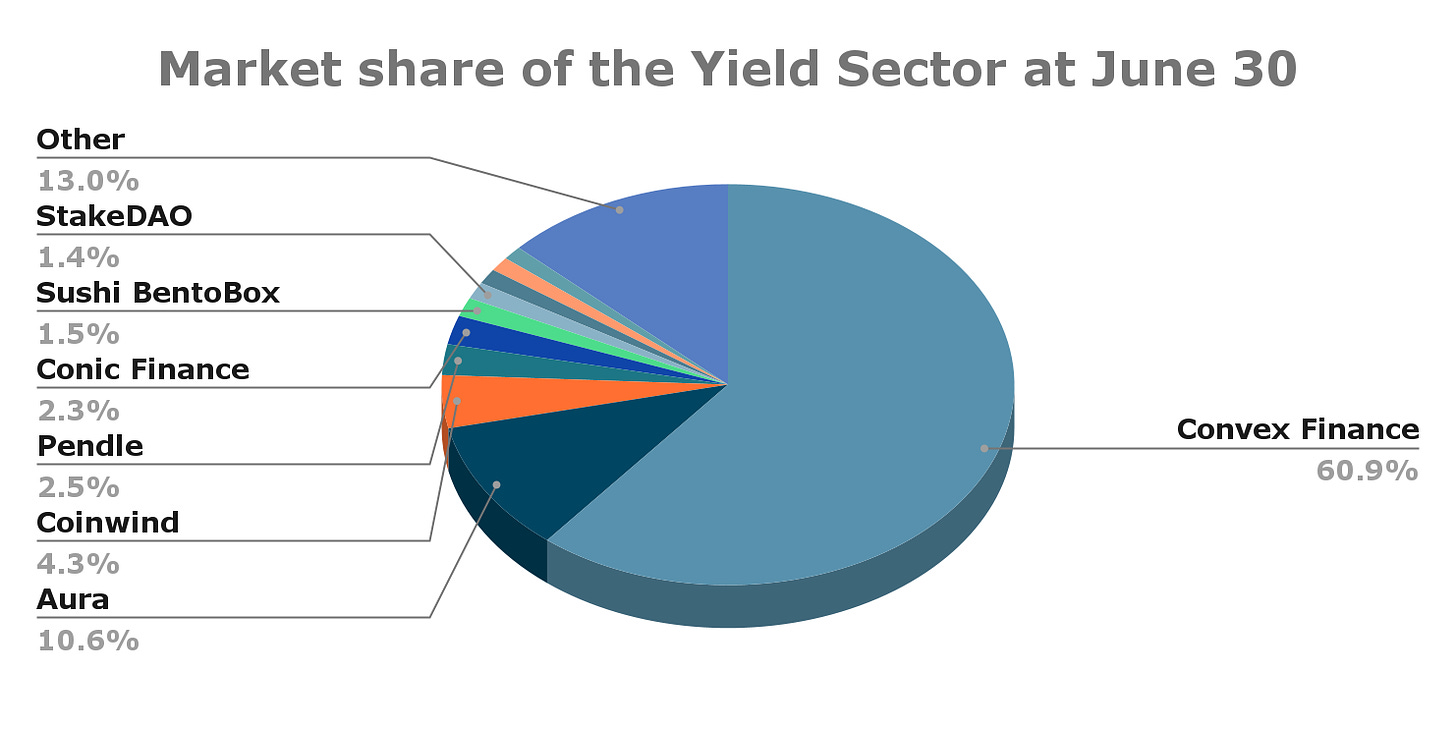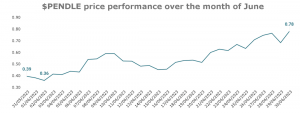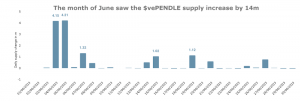
Published: July 07, 2023
The Pendle protocol enables permissionless tokenization and trading of yield. Pendle allows anyone to purchase assets at a discount, and obtain a fixed yield, or long DeFi yield.
In DeFi, when it comes to the Yield sector, Pendle currently has the fourth-largest Total Value Locked (TVL).
This report takes a look at the performance of Pendle over the period June 1 to June 30.
It will cover the key metrics of the protocol, the yield sector, the $PENDLE token, trading metrics, and other events.
Pendle opened the period at $80m in TVL and closed at $125m, representing a 55.81% increase. This is a continuation of the strong growth from the previous period (May 1 – May 30) when TVL increased by 27%.
Pendle’s TVL on Ethereum opened the month at $50.7m and experienced a $19.3m (38.13%) increase, closing at $70.1m. On Arbitrum, balances opened at $28.6m and closed at $53.7m, a $25m (88.07%) increase.
The graph below is a representation of TVL changes over the last two months.

The drivers for the increase were:
The Yield sector of DeFi is dominated by Convex followed by Aura; they contribute 60.9% and 10.6%, respectively, to the sector TVL. Pendle contributes 2.5% to the sector TVL.

Over both the current and previous months, Pendle has experienced steady growth in its sector dominance. This was aided by the introduction of Liquid Staking Tokens into the protocol.
The graph below illustrates how sector dominance has grown since April 30.

Volume
Over June, Pendle generated a total volume of $23.8m, a $10.9m (83.86%) increase from May.
The volume growth was achieved on both networks, with 60% of the protocol’s monthly volume taking place on Arbitrum. The launch of $wstETH and $rETH pools on June 7 was the driving factor for Arbitrum’s growth.
The average Capital Efficiency Rate* for the protocol over the period was 0.7%, with a daily high of 1.65% and a daily low of 0.13%
The graph below illustrates the daily volume (at a network level) and the capital efficiency of the protocol. Both these metrics have ascending trend lines over the month.

*Capital Efficiency is an indicator of how efficiently TVL in liquidity pools generates volume. It is calculated by taking the volume divided by TVL and converted to a percentage. It is a measure of how productive funds are at generating volume, but it is not a direct indicator of revenue. Higher capital efficiency does not mean higher revenue
At June 30 the largest liquidity pools were:
As part of yield trading, Pendle users can buy and sell Principal Tokens (PTs) or Yield Tokens (YTs).
For both PT and YT tokens, the implied APY is dependent on the price which can move independently from the APY of the underlying asset.
Holding the Principal Token (PT) enables you to redeem the principal amount after maturity; one PT can be redeemed for one underlying unit at maturity.
When it comes to trading PT tokens:
It is important to remember that, while the implied yield for PT changes, you lock in the rate at the time of purchase.
You can find out more about PT tokens in our Pendle Breakdown.
The chart below illustrates your position if you acquired a PT token on the respective day for each of the three largest pools. The percentages highlighted are the highs/lows in the month.
A positive percentage: means that the implied yield was greater than the underlying yield, therefore traders would have been better off purchasing the PT compared to the underlying asset. The opposite is true for negative percentages.
Please note: The profit and loss spreads only apply if traders hold until maturity.

The key takeaways are:
Holding the Yield Tokens (YT) enables users to continuously earn the yield produced by the underlying asset. It can be claimed in real-time up until maturity.
When it comes to trading YT tokens:
It is important to remember that YT tokens earn the yield of the underlying asset.
You can find out more about YT tokens in our Pendle Breakdown
The chart below illustrates your position if you acquired a YT token on the respective day for each of the three largest pools. The percentages highlighted are the highs/lows in the month.
A positive percentage: means that the underlying yield was greater than the implied yield, therefore traders had a higher likelihood to make a profit. The opposite is true for negative percentages.

The key takeaways are:
The $PENDLE token opened the month at $0.39 and closed at $0.78, a 97.5% increase.
On June 2 it reached a low of $0.36 before having a steady upward trajectory and closing at its monthly high.

The circulating market cap followed the same trend as the price, opening at $38m and closing at $75m. Pendle holds the 275th rank for circulating market cap on CoinGecko.
Of the top five protocols in the Yield Sector, Pendle was the only one to have positive price growth in June.

The month of June saw 4m $PENDLE issued as reward incentives, with an approximate value of $2.2m
Pendle has implemented a vote escrow model, where $PENDLE holders can lock tokens for up to two years. The longer the lock duration the more $vePENDLE a user gets.
For more information on locking $PENDLE, you can read about it in our Pendle breakdown
The recent expansions and product releases have resulted in more $PENDLE being locked. At the end of June, the $vePENDLE supply was 28.9m.

$vePENDLE holders benefit from the various revenue streams of the protocols. Over the month of June, $33k in $ETH was distributed, representing an APR of 38.9%
There were no significant governance proposals during the period.
There was four notable news event that was published in the period.
With the latest addition, Pendle now boasts a lineup of 4 $stETH pools, each offering different maturity dates ranging from June 2023 to December 2027.
For more information, you can read about it here.
Users can earn underlying staking yield from $swETH, and lending yield from $bbaWETH lent out on Aave.
For more information, you can read about it here.
For more information, you can read about it here.
Having a $wstETH pool with a shorter maturity (Jun 2024 vs. Jun 2025) opens up the playing field for more users with different needs and horizons.
For more information, you can read about it here.
Dolomite is a decentralized money market and DEX built on Arbitrum, supporting lending, borrowing, trading, margin, and hedging.
This gives a new utility to PT-GLP, expanding Pendle products’ use cases.
For more information, you can read about it here.
This report has highlighted the pricing trends and metrics for the period.
Pendle is the fourth-largest yield protocol and is experiencing a period of growth. This would be growth in terms of TVL, product offerings, and price appreciation.
We hope this report provides valuable insights into the performance
Revelo Intel has a commercial relationship with Pendle and this report is part of that relationship.
The Revelo Intel team members, including those directly involved in the analysis above, may have positions in the tokens discussed.
This content is provided for educational purposes only and does not constitute financial or investment advice. You should do your own research and only invest what you can afford to lose. Revelo Intel is a research platform and not an investment or financial advisor.